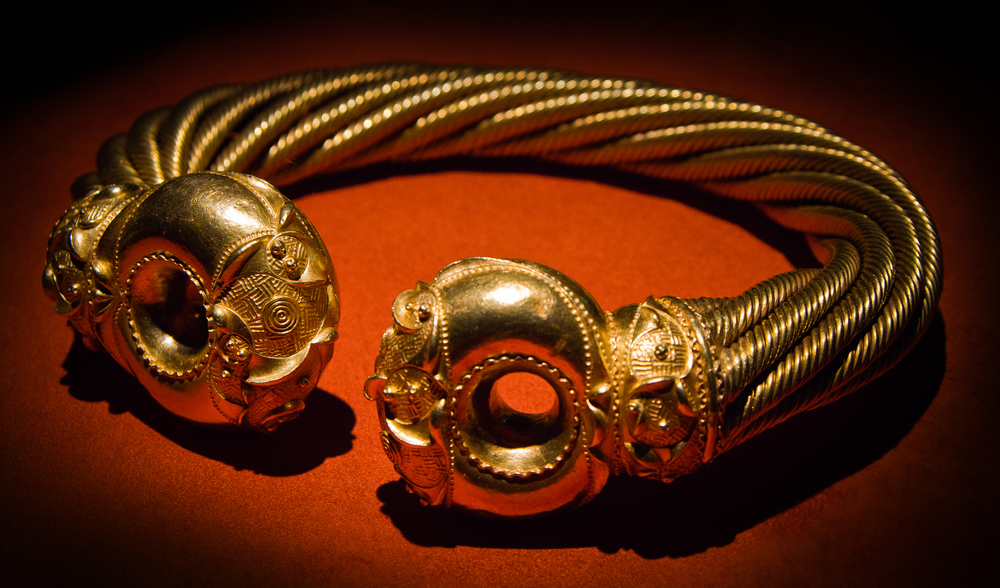Throughout history, jewelry has been a symbol of status, wealth, and power. Though the wealthiest may have adorned themselves in precious gems, stones, and metals, in the ancient world, jewelry was used for a variety of reasons — and came in many different shapes and sizes.
The tomb of one Queen Puabi — discovered in the Royal Cemetery of Ur in modern-day Iraq — is a striking example of the riches worn by ancient elites. Her tomb contained magnificent pieces including a headdress of gold leaves, necklaces, chokers, earrings, and ten rings, amongst many more examples crafted from precious metals and stones.
Queen Puabi’s burial complex belonged to the Sumerian people and dates back to 2600 B.C.E. Her tomb is considered as one of the most “lavish” ever found in Mesopotamia.
Digging Up Treasures
Archaeologists regularly discover jewelry in grave sites. In 2024, researchers in central Italy uncovered a cemetery packed with jewelry such as rings, gold necklaces, and amulets, indicating that many of the tombs belonged to some of ancient Rome’s wealthiest elites.
Read More: A Stone Age Village Buried a Mysterious Girl with Fine Jewelry Befitting Ancient Egypt
While such magnificent discoveries give an insight into what the rich and powerful wore in ancient societies, jewelry may have been worn by people of all walks of life — and for many different reasons, according to Alexis Castor, an assistant professor of classics at Franklin and Marshall College.
Castor explains that most people in ancient cultures, like those of Egypt, Greece, and Rome, probably wore jewelry at some point in their lives.
Ancient Amulets Were Powerful Tokens
Materials used for jewelry ranged from precious metals and stones to organic materials like leather and textiles. Some of these materials, such as amber, had both an aesthetic value and were regarded for their “mystical purposes”, says Castor.
Such beliefs led to a widespread use of protective amulets among many ancient cultures. “When babies were born, they were probably immediately decorated with amulets to protect them against the many dangers that threatened their lives,” adds Castor.
A faience Egyptian frog amulet depicting Heqet, the goddess of fertility. (Credit: dmitriymoroz/Getty Images)
In ancient Egypt, for example, amulets depicted a variety of deities, animals or even everyday objects. Crafting them from certain materials was also believed to imbue them with additional power. Faience, a man-made material, came to be associated with powers of regeneration.
“Amulets are a little bit like watches, something that doesn’t have a gender connection but is part of your daily dress,” Castor adds. “Amulets are a very functional form of jewelry. They’re intended to help you get rich, protect you from illness or enemies, or find a partner.”
Read More: Cosmic Rays Reveal Mystery Chamber From Ancient Greece
She cites the example of the Greek leader and statesman Pericles — a key player in Athen’s democracy who lived from 495 to 429 B.C.E. — who is known to have worn an amulet to protect him against the plague. Unfortunately for the Greek leader, it didn’t stave off his death, Castor notes.
Likewise, rings were commonly used by both men and women. In Roman times, rings were loosely associated with marriage, though not in the form of wedding rings as we know them. Rings also served other purposes, such as a seal, while only noblemen and senators wore gold rings under the Roman Republic, as they denoted status. This changed over time, as a wider variety of metals became more commonly worn by other classes.
Different Types of Jewelry Had Different Meanings
Oftentimes, the purpose of some kinds of jewelry is open to interpretation. In ancient Egypt, some believe that the gift of elaborate golden fly necklaces is associated with military honors. A famous example is the necklace gifted to Queen Ahhotep by her sons for her role in fighting the Hyksos, though this is questioned and may instead be linked to protection and renewal in the afterlife.
Celtic torcs, fashioned widely across Europe, were also associated with status but likely held symbolic significance for the wearer. These items were made from gold, bronze, copper, and silver and were worn by men, women, and possibly even children.
A Celtic torc is rigid wrist or neck adornment, often made from bronze, copper, silver, and gold. (Credit: Andres Victorero/Getty Images)
Read More: Ancient Ceramics and Beading Shed Light on Human Life Over 20,000 Years Ago
Not all the ancients were enamored with jewelry. The Roman writer Pliny the Elder, for example, railed against what he believed was an ostentatious obsession with self-adornment. In his Natural History, he recounts witnessing Lollia Paulina, wife to the emperor Caligula, covered in emeralds and pearls “which shone in alternate layers upon her head, in her hair, in her wreaths, in her ears, upon her neck, in her bracelets, and on her fingers.”
How Was Ancient Jewelry Made?
Given the vast array of materials and objects worn as jewelry, there were many different methods of crafting them. Torcs, for example, were made from twisted strands of metal; these elaborately crafted items are often found in grave sites, as well as treasure hordes.
One example, known as the Snettisham Great Torc, was made from sixty-four threads comprised of over 1 kilogram (or 2.2 pounds) of gold and silver. Other pieces required the work of stone cutters, crafters, and goldsmiths.
“The techniques are pretty standard,” Castor explains, adding that the use of moulds was widespread to craft jewelry. “The two decorative techniques of filigree, where you add decorative wire, and granulation, the use of these small grains of gold to decorate a surface, are the most common.”
Read More: The Ancient Celts: Iron Age Foes of Rome Who Left Behind More Than Weapons
As much as we know about ancient jewelry and how it was made, Castor says that many questions still remain. “We don’t really know what the lifecycle of jewelry was,” she says. “I would love to know how much jewelry, women had at different economic statuses.”
Article Sources
Our writers at Discovermagazine.com use peer-reviewed studies and high quality sources for our articles, and our editors review for scientific accuracy and editorial standards. Review the sources used below for this article:














